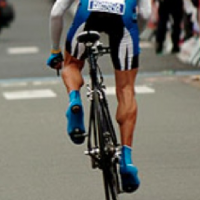I love learning and to be among those who are humble enough to share that passion. Sometimes we underestimate how difficult it can be to learn, particularly as we gain knowledge or as time passes. Kinda sounds odd, but as we gain knowledge, we formulate an opinion on what we are willing to accept or not. So for some, the more we know, the more difficult it is to learn. The cycling community and especially indoor cycling instructors can be a difficult bunch to hit with seemingly controversial concepts. This is one of the reasons I love those of us in the ICA community. We are open and eager and resemble human sponges when it comes to learning. Nothing thrills an educator more.
An introduction like that only alerts you that this article may be of controversial nature. Depending on who you are and where you came from, it just might be.
The Question:
Should you (or is it correct to) push the heels down when pedaling?
The Short Answer:
This article from our archives was originally posted in 2013, written by cycling and biomechanics expert Tom Scotto. Unfortunately, to this day, instructors cueing to “push the heels down” during the pedal stroke is still rampant. If they could only understand that they are inhibiting their riders’ potential power output while stifling a smooth pedal stroke.


Hi Tom. I love this stuff, thanks for the info. One of the formats I teach is Les Mills Sprint. It’s not presented as a cycling class, it’s a HIIT class using a bike as a tool. The intervals include sprints, power, and strength. The power blocks use the pedal stroke technique you describe in this article…but for sprints we are instructed to tell participants to dip toes (slightly) for top speed. For strength work (simulating a leg press), we are instructed to tell participants to drive with their heel. Is this going to hurt them?
Guilty! Thanks, Tom, for this enlightening explanation. I have repeated this mantra, but not very often, thank goodness! And yes, that is what I was taught. For my riders who do not clip in, I emphasize the importance of NOT pushing their foot all the way to the end of the basket…instead, making sure the ball of their foot is centered over the pedal (crankshaft.) “No-one ever told name that” is a frequent response I would often get and “my foot would fall asleep.” Do you have any other guidance (or cues) for those riders not clipped in? If riders are in for the long haul, I do speak of the benefits of clipping in when ever they are ready. And in the spirit of Thanksgiving, I am so thankful for ICA and the many opportunities to continually learn and grow as an instructor.
For quicker speeds, I like to use the cues: “Keep your feet moving ahead of the pedal” or “Let the pedals work to catch up to you”…do you see any potential form issues in either of those?
I suggest to my participants to picture a tomato underneath the arch of their foot, think of massaging their foot. They don’t want to squeeze the tomato. Keeping leg light on the pedal. What do you think.?
When I teach intro classes the first thing I talk about is form, starting from the toes and working up the body. With newbies that means that I have to address their tendency to adopt a toe-down position. I ask them to relax and feel their feet settle into an approximately level position. Of course, their next tendency is to push their heels down to achieve that (on your first time on the bike it is hard to hear and act on the word ‘relax’). So then I have them pedal slowly with first an exaggerated toe down position and then a heel down position. They can then feel the antagonist muscles at work and are committed to a better foot position – all in the first five minutes of class. We then talk about ankles and in their second class I sometimes use a skeleton to show what is happening at their ankles. Addressing this early means no one practices imperfect form and gives me something to reinforce even if they are struggling with other aspects of the class.
Once I have successfully coached them toward a middle ground between toes down and heesl down, then over the next few weeks I can coach for a firm but not stiff foot.
What a great post Tom Scotto! I thoroughly enjoy reading your articles, especially on form and technique and I ALWAYS learn something! Thank you ; )
You are most welcome Leslie. Don’t forget to add your expertise so we can both learn 😉
I always instruct my students to keep their feet in a horizontal position, all through the pedal stroke, this is still correct right?
Tom, keeping a riders foot horizontal throughout the pedal stroke would also unfortunately require improper muscle engagement (to keep the heel down) and restrict ankling. Think “firm” and not “stiff”. The foot/ankle should be allowed to move smoothly through the entire pedal stroke. I’m going to post a video of the pros from the USA Cycling Challenge as a demonstration of the technique/movement.